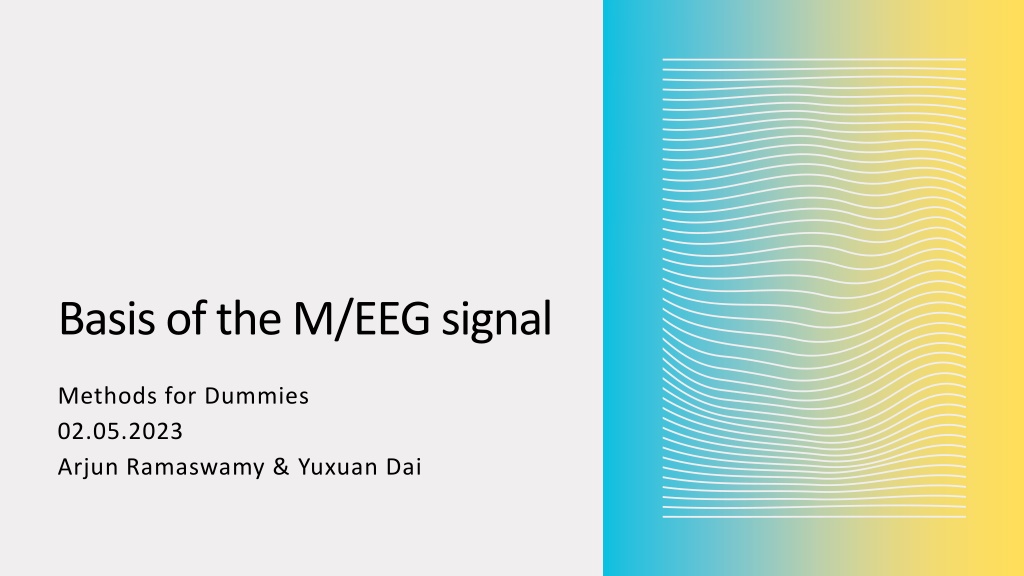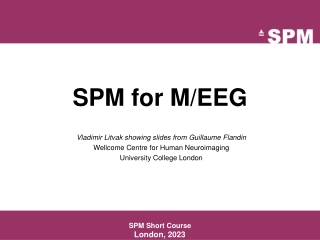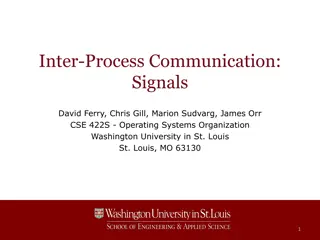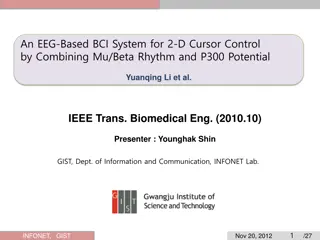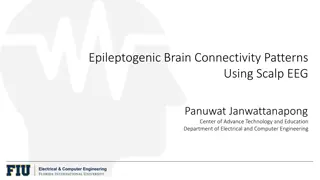Basis of the M/EEG signal
This informative guide delves into the basics of M/EEG signal methods, covering topics such as the biophysical origin of M/EEG, historical background, measurement techniques, and the distinction between EEG and MEG. It explores the history of human EEG, the concept of action potentials, and the practical aspects of recording and interpreting brain signals using electrodes. Through detailed explanations and visual aids, readers gain insight into the fascinating realm of electroencephalography and magnetoencephalography.
Download Presentation

Please find below an Image/Link to download the presentation.
The content on the website is provided AS IS for your information and personal use only. It may not be sold, licensed, or shared on other websites without obtaining consent from the author.If you encounter any issues during the download, it is possible that the publisher has removed the file from their server.
You are allowed to download the files provided on this website for personal or commercial use, subject to the condition that they are used lawfully. All files are the property of their respective owners.
The content on the website is provided AS IS for your information and personal use only. It may not be sold, licensed, or shared on other websites without obtaining consent from the author.
E N D
Presentation Transcript
Basis of the M/EEG signal Methods for Dummies 02.05.2023 Arjun Ramaswamy & Yuxuan Dai
Overview Introduction and History Biophysical origin of M/EEG Why do we use M/EEG? Measurement of M/EEG
Part 1 Introduction and History Biophysical origin of M/EEG Why do we use M/EEG? Measurement of M/EEG
What is M/EEG Electro Electric encephalon brain gram picture Magneto Magnetic Refers to the study of the electric and magnetic fields of the encephalon (the brain) EEG: Measures differences in electric potentials on the scalp (Units: micro Volt) MEG: Measures changes in magnetic flux density outside of the head (Units: femto Tesla) EEG and MEG are the most powerful techniques to noninvasively study the electrophysiological dynamics of the brain (Cohen 2017)
History of Human EEG In 1929, Hans Berger developed human EEG, the graphic representation of the difference in voltage between two different cerebral locations plotted over time He described the human alpha and beta rhythms Example calculation: PO - Parietal Occipital electrode number 7 Cz - Reference electrode (usually forehead) g - ground electrode (usually the ears) 1929 - EEG Equipment (Left), Hans Berger (Right)
Part 2 Introduction and History Biophysical origin of M/EEG Why do we use M/EEG? Measurement of M/EEG
Biophysical origin - What is an action potential? Rapid, transient, all-or-none current flow from the cell body to the axon terminal of a neuron is known as an action potential (AP) To be registered by electrodes on the scalp many neurons would need to fire at the same time, which is unlikely given that action potentials lasts around ~1ms APs are unlikely to contribute to M/EEG Action potentials are Biphasic and brief Too short APs produce electric quadropoles, which their intensity decline steeply with distance (1/r3).
Biophysical origin - What is a post synaptic potential? After an action potential, neurotransmitters are released They bind to the receptors of a postsynaptic neuron Monophasic Sustained Scalp EEG is a summation of synchronous, post-synaptic potentials which arise relatively slower than action potentials (~ 10ms). EPSPs Excitatory Post Synaptic Potentials IPSPs Inhibitory Post Synaptic Potentials
Biophysical origin Neuronal Current When an EPSP is generated in the dendrites of a neuron, Na+ flow inside the neuron s cytoplasm creating a current sink. - The current completes a loop creating a dipole further away from the excitatory input (where Na+ flows outside the cell as passive return current), which can be recorded as a positive voltage difference by an extracellular electrode. Large numbers of vertically oriented, neighboring pyramidal neurons create these field potentials. Thus, EEG detects summed synchronous activity (PSPs) from many thousands of apical dendrites of neighbouring pyramidal cells (mainly). +
Biophysical origin - post synaptic potential (PSP) Scalp Skull CSF Spocter et al, (2017) Cortex White matter
Across brain imaging modalities : spatial vs. temporal resolution
Part 3 Introduction and History Biophysical origin of M/EEG Why do we use M/EEG? Measurement of M/EEG
Why do we use EEG EEG is used to evaluate several types of brain disorders. When epilepsy is present, seizure activity will appear as rapid spiking waves on the EEG. People with lesions of their brain, which can result from tumors or stroke, may have unusually slow EEG waves, depending on the size and the location of the lesion. The test can also be used to diagnose other disorders that influence brain activity, such as Alzheimer's disease, certain psychoses, and a sleep disorder called narcolepsy. The EEG may also be used to determine the overall electrical activity of the brain (for example, to evaluate trauma, drug intoxication, or extent of brain damage in comatose patients). The EEG may also be used to monitor blood flow in the brain during surgical procedures.
EEG Rhythms Brain wave samples for different waveforms Brain waves are oscillating electrical voltages in the brain measuring just a few millionths of a volt. There are five widely recognized brain waves, and the main frequencies of human EEG waves are listed below.
Part 4 Introduction and History Biophysical origin of M/EEG Why do we use M/EEG? Measurement of M/EEG
EEG Acquisition Electrodes: Usually made of silver (or stainless steel) active electrodes placed on the scalp using a conductive gel or paste. Signal-to-noise ratio (impedance) reduced by light abrasion. Can have 32, 64,128, 256 electrodes. More electrodes = richer data set. Reference electrodes (arbitrarily chosen zerolevel , analogous to sea level when measuring mountain heights) commonly placed on the midline, ear lobes, nose, etc. Amplification: i.e. there is one amplifier per pair of electrodes. The amplifier amplifies the difference in voltage between these two electrodes, or signals (usually between 1000 and 100 000 times). This is usually the difference between an active electrode and the designated reference electrode.
EEG Signal Detection EEG records potential differences at the scalp using a set of active electrodes and a reference (ground) electrode. The reference electrode is important as it eliminates noise from the amplifier circuit The representation of the EEG channels is referred to as a montage Unipolar/Referential: potential difference between an electrode and a designated reference Bipolar: represents the difference between a pair of adjacent electrodes Potential differences are amplified, filtered and digitized.
Intro to MEG MEG stands for Magnetoencephalography measure small magnetic fields produced by changes in the electrical activity within the brain millisecond direct and non-invasive Magnetic field measurements are in the range of femto-tesla to pico-tesla The magnetic field passes unaffected through brain tissue and the skull, so it can be recorded outside the head Usages: - find the neuronal sources within the brain - clinical practice (epilepsy) https://en.wikipedia.org/wiki/Magnetoencephalography
Biophysical origin of MEG The basic physics principle: moving current creates a magnetic field based on the right hand rule MEG magnetic field is not affected by the various properties of the scalp and head as it is with the EEG signal right hand rule
Primary vs. Secondary current Magnetic fields are mainly induced by primary currents whereas electric fields are mainly sensitive to secondary (volume) currents Magnetic field is generated perpendicular to electric field, from both the primary and secondary currents
Geometry of neurons Pyramidal cells! A large number of neurons have to be active simultaneously to generate a measurable M/EEG signal ~ 50,000 neurons Neurons that give the main contribution to the MEG or the EEG are those that form open fields
Radial vs. Tangential sources MEG sees only those magnetic fields that have a component perpendicular to the skull. sensitive to magnetic fields generated by neuronal currents that have a component oriented tangentially to the skull less sensitive to radial dipoles But in practice, only a small proportion (<1%) of cell populations are perfectly radial i.e. on top of gyri radial tangential
Measurement of MEG Signal Magnetic fields created by the brain are extremely small! do not exceed a few hundred femto tesla (10 15T) Earth's magnetic field: 10 4~ 10 5T MRI: 1.5-3 T Interfering noise electrical equipment urban environment participant s heartbeat or muscle Two basic issues: how to record these small magnetic fields how to shield out the earth's relatively stronger magnetic fields
Measurement of MEG Signal: SQUIDS superconducting quantum interference devices (SQUIDs) flux-locked loop SQUIDs are made from materials that become superconductors at extremely low temperatures, meaning that the material can conduct electricity without resistance A highly sensitive magnetic field meter > 300 SQUID sensors Cryogenic kept in a superconducting state by liquid helium at 4 K (approximately 269 C)
Measurement of MEG Signal: pick-up coils less sensitive to outside noise two types of gradiometers: axial and planar axial: sensitive at measuring deep sources ( 5 times the signal strength on 8-cm depth sources) planar: more sensitive at measuring the shallow sources provide the best signal and are most sensitive to shallow and deep brain sources but are more prone to picking up outside noise
Magnetically shielded room (MSR) The primary means of reducing external magnetic interference is to perform MEG recordings inside a magnetically shielded room (MSR) Concentric shells of multiple layers of copper mu-metal and aluminium external magnetic field bends around of MSR
OPMs A new generation of MEG optically pumped magnetometers (OPMs) also known as atomic magnetometers Increased signal sensitivity closer to the scalp: not cryogenic but higher sensor noise less sensors freedom of participant mobility during scanning Boto et al. (2018)
MEG vs. EEG EEG MEG 10 mV (easily detectable) 10 fT (magnetic shielding required) Secondary currents Primary currents (dominantly) and secondary currents Signal unaffected by skull/scalp Distortion by skull/scalp ~1ms ~1ms Poor spatial resolution~1cm Potentially good spatial resolution 2-3 mm Moves with subject Movement incompatible (cryogenic MEG) Cheap, widely available Expensive, limited availability Sensitive to both tangential and radial sources (gyri and sulci) Sensitive mainly to superficial tangential sources (cortical sulci)
Thank you for listening. We are happy to answer any questions!
References https://en.wikipedia.org/wiki/Magnetoencephalography http://web.mit.edu/kitmitmeg/whatis.html https://ilabs.uw.edu/what-magnetoencephalography-meg/ Boto, E., Holmes, N., Leggett, J., Roberts, G., Shah, V., Meyer, S. S., Mu oz, L. D., Mullinger, K. J., Tierney, T. M., Bestmann, S., Barnes, G. R., Bowtell, R., & Brookes, M. J. (2018). Moving magnetoencephalography towards real-world applications https://doi.org/10.1038/nature26147 Cohen, D. (1972). Magnetoencephalography: Detection of the Brain s Electrical Activity with a Superconducting Magnetometer. Science, 175(4022), 664 666. da Silva, F. H. L. (2010). Electrophysiological Basis of MEG Signals. In P. Hansen, M. Kringelbach, & R. Salmelin (Eds.), MEG: An Introduction to Methods (p. 0). Oxford University Press. https://doi.org/10.1093/acprof:oso/9780195307238.003.0001 H m l inen, M., Hari, R., Ilmoniemi, R. J., Knuutila, J., & Lounasmaa, O. V. (1993). Magnetoencephalography Theory, instrumentation, and applications to noninvasive studies of the working human brain. Reviews of Modern Physics, 65(2), 413 497. https://doi.org/10.1103/RevModPhys.65.413 Kim, J. A., & Davis, K. D. (2021). Magnetoencephalography: Physics, techniques, and applications in the basic and clinical neurosciences. Journal of Neurophysiology, 125(3), 938 956. https://doi.org/10.1152/jn.00530.2020 Niedermeyer, E., & Silva, F. H. L. D. (Eds.). (2004). Electroencephalography: Basic Principles, Clinical Applications and Related Fields (5th edition). Lippincott Williams and Wilkins. Robinson, S. (1999). Functional neuroimaging by Synthetic Aperture Magnetometry (SAM). Singh, S. P. (2014). Magnetoencephalography: Basic principles. Annals of Indian Academy of Neurology, 17(Suppl 1), S107 S112. https://doi.org/10.4103/0972- 2327.128676 https://www.ncbi.nlm.nih.gov/books/NBK390354/pdf/Bookshelf_NBK390354.pdf https://journals.plos.org/plosone/article?id=10.1371/journal.pone.0093154 https://nobaproject.com/modules/neurons https://faculty.washington.edu/chudler/ap.html https://www.sciencedirect.com/topics/agricultural-and-biological-sciences/brain-waves https://www.wikiwand.com/en/Hans_Berger Aydin , Vorwerk J, K pper P, Heers M, Kugel H, Galka A, et al. (2014) Combining EEG and MEG for the Reconstruction of Epileptic Activity Using a Calibrated Realistic Volume Conductor Model. PLoS ONE 9(3): e93154. https://doi.org/10.1371/journal.pone.0093154 with a wearable system. Nature, 555(7698), Article 7698.
Biophysical origin Dipoles and currents EPSPs of parallel dendrites in cortical columns creates Primary current (what we want to know about) Secondary/volume currents Measured by EEG Influenced by intervening tissue Magnetic field perpendicular to primary current Measured by MEG Unaffected by intervening tissue
